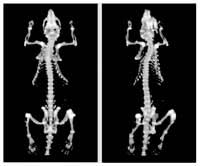Body Scanners for Lab Animals

This MicroPET scan of a live rat shows the skeleton.
A PET (positron emission tomography) scanner sensitive enough to use on laboratory mice has been developed by biomedical engineers at UC Davis. The device is already being used for studies on prostate cancer.
“We think it’s the highest resolution scanner in existence. We can see things we couldn’t see before,” said Simon Cherry, professor of biomedical engineering at UC Davis, who leads the research group.
PET scanners have become widely used in medical imaging, alongside X-rays, CAT scans and magnetic resonance imaging, because they can give information about metabolic activity in body tissues. The machines used for scanning people cannot see sufficiently fine detail for use on small animals such as mice and rats.
The current machine, called MicroPET II, can resolve a volume of about one cubic millimeter, or one microliter, Cherry said. That represents an approximately eight-fold improvement over an earlier device built by Cherry’s laboratory at UCLA, before moving to UC Davis in 2001.
PET works by detecting short-lived radioactive tracers that emit positrons, or anti-electrons. Those tracers can be attached to other molecules that are targeted to particular cells. For example, highly active cells, such as cancer cells, can be tagged with radioactive glucose.
Non-invasive imaging technology such as PET allows researchers to gain more information and to use fewer animals in experimental studies. For example, researchers could use an experimental drug to treat cancer in mice and see if the tumors were shrinking. Without methods such as PET, small deposits of cancer cells are hard to detect in experimental animals.
Cherry presented the work at the annual meeting of the Society for Molecular Imaging in San Francisco, Aug. 15-18. The work has also been published in the journal Physics in Medicine and Biology.
Media contact(s):
Andy Fell, UC Davis News Service, (530) 752-4533, ahfell@ucdavis.edu
Media Contact
More Information:
http://www.news.ucdavis.edu/search/news_detail.lasso?id=6630All latest news from the category: Life Sciences and Chemistry
Articles and reports from the Life Sciences and chemistry area deal with applied and basic research into modern biology, chemistry and human medicine.
Valuable information can be found on a range of life sciences fields including bacteriology, biochemistry, bionics, bioinformatics, biophysics, biotechnology, genetics, geobotany, human biology, marine biology, microbiology, molecular biology, cellular biology, zoology, bioinorganic chemistry, microchemistry and environmental chemistry.
Newest articles

Time to Leave Home? Revealed Insights into Brood Care of Cichlids
Shell-dwelling cichlids take intense care of their offspring, which they raise in abandoned snail shells. A team at the Max Planck Institute for Biological Intelligence used 3D-printed snail shells to…

Smart Fabrics: Innovative Comfortable Wearable Tech
Researchers have demonstrated new wearable technologies that both generate electricity from human movement and improve the comfort of the technology for the people wearing them. The work stems from an…

Going Steady—Study Reveals North Atlantic’s Gulf Stream Remains Robust
A study by the University of Bern and the Woods Hole Oceanographic Institution in the USA concludes that the ocean circulation in the North Atlantic, which includes the Gulf Stream,…



